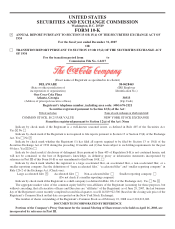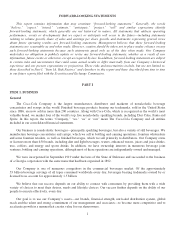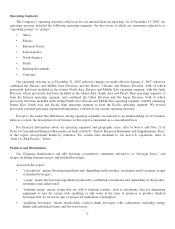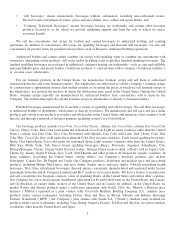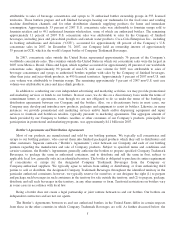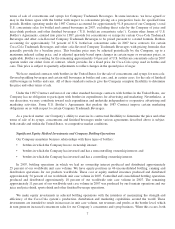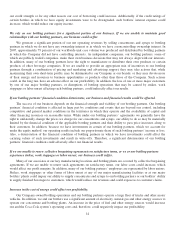Coca Cola 2007 Annual Report Download - page 6
Download and view the complete annual report
Please find page 6 of the 2007 Coca Cola annual report below. You can navigate through the pages in the report by either clicking on the pages listed below, or by using the keyword search tool below to find specific information within the annual report.Consumer demand determines the optimal menu of Company product offerings. Consumer demand can vary from
one locale to another and can change over time within a single locale. Employing our business strategy, and with
special focus on core brands, our Company seeks to build its existing brands and, at the same time, to broaden its
historical family of brands, products and services in order to create and satisfy consumer demand locale by locale.
During 2007, we expanded our still beverage offerings by acquiring Energy Brands Inc., also known as glacéau,
the maker of enhanced water brands such as vitaminwater, fruitwater and smartwater, and vitaminenergy; Fuze
Beverage, LLC (“Fuze”), the maker of the Fuze fortified beverages, enhanced water, tea-flavored beverages, and sports
and fruit drinks; and Leao Junior, S.A. (“Leao Junior”), a Brazilian herbal beverage company. Also during 2007, we
and Coca-Cola FEMSA, S.A.B. de C.V. jointly acquired Jugos del Valle, S.A.B. de C.V. (“Jugos del Valle”), the
second largest producer of packaged juices, nectars and fruit-flavored beverages in Mexico and the largest producer of
such beverages in Brazil. In addition, during 2007, our Company introduced a variety of new brands, brand extensions
and new beverage products. Among numerous examples, in the United States, the Company launched Dasani Plus
enhanced water beverages, Vanilla Coke Zero and the Minute Maid Enhanced Juice line; and in Canada, we launched
the Fanta brand of sparkling beverages. In Latin America, the products launched included Coca-Cola Zero, Fanta Zero,
Lift Zero, Fresca Zero, Lift + Manzana, Fresca Lado B, Dasani and Flanm. In Europe, new launches included Diet
Coke Plus in Great Britain, Coke Zero in Austria and Switzerland, Coca-Cola Blak in the Czech Republic and
Slovakia, and Fruitopia by Minute Maid in Germany. We also launched Damla, a spring water, in Turkey; Coke Zero
in Croatia and Romania; and Next Joy in Serbia. In the Middle East, we launched Burn, Cappy juice, and Jericho and
Sahtain waters. In Pakistan, we launched Sprite 3G and in Kazakhstan, Cappy juice. Also, in Japan we launched
Ayataka, a premium ready-to-drink green tea.
Our Company measures the volume of products sold in two ways: (1) unit cases of finished products and
(2) concentrate sales. As used in this report, “unit case” means a unit of measurement equal to 192 U.S. fluid ounces of
finished beverage (24 eight-ounce servings); and “unit case volume” means the number of unit cases (or unit case
equivalents) of Company beverage products directly or indirectly sold by the Company and its bottling partners
(“Coca-Cola system”) to customers. Unit case volume primarily consists of beverage products bearing Company
trademarks. Also included in unit case volume are certain products licensed to, or distributed by, our Company, and
brands owned by Coca-Cola system bottlers for which our Company provides marketing support and from the sale of
which we derive economic benefit. Such products licensed to, or distributed by, our Company or owned by Coca-Cola
system bottlers account for a minimal portion of total unit case volume. In addition, unit case volume includes sales by
joint ventures in which the Company has an equity interest. Although most of our Company’s revenues are not based
directly on unit case volume, we believe unit case volume is one of the measures of the underlying strength of the
Coca-Cola system because it measures trends at the consumer level. The unit case volume numbers used in this report
are based on estimates received by the Company from its bottling partners and distributors. Concentrate sales volume
represents the amount of concentrates, syrups, beverage bases and powders (in all cases expressed in equivalent unit
cases) sold by, or used in finished beverages sold by, the Company to its bottling partners or other customers.
“Concentrate sales” replaced the “gallon sales” concept beginning with the first quarter of 2007. We made this change
primarily to replace “equivalent gallons” with “equivalent unit cases” as a unit of measurement for concentrates,
syrups, beverage bases and powders, which better reflects how our Company conducts its operations. Most of our
revenues are based on concentrate sales, a primarily wholesale activity. Unit case volume and concentrate sales growth
rates are not necessarily equal during any given period. Items such as seasonality, bottlers’ inventory practices, supply
point changes, timing of price increases, new product introductions and changes in product mix can impact unit case
volume and concentrate sales and can create differences between unit case volume and concentrate sales growth rates.
In 2007, concentrates and syrups for beverages bearing the trademark “Coca-Cola” or any trademark that includes
“Coca-Cola” or “Coke” (“Coca-Cola Trademark Beverages”) accounted for approximately 53 percent of the
Company’s total concentrate sales.
In 2007, concentrate sales in the United States (“U.S. concentrate sales”) represented approximately 24 percent of
the Company’s worldwide concentrate sales. Approximately 56 percent of U.S. concentrate sales for 2007 was
4

